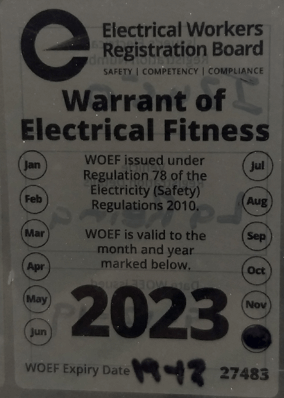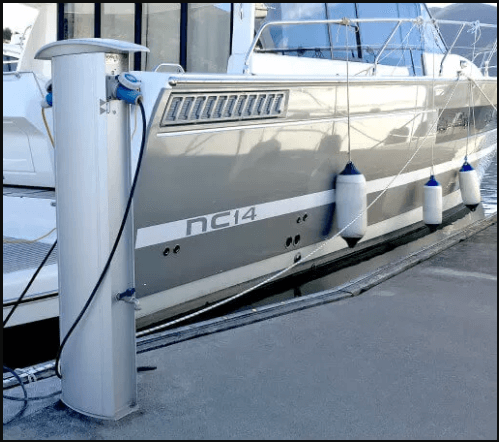Electrical Warrants of Fitness and Connecting to Shore Power
Fire and electrocution are one of the biggest marina hazards. Lives and property can be at risk. Doing your part to keep your boat’s electrics in order will help keep everyone safe. Marina operators can’t legally supply shore power to a vessel without a current Vessel Electrical Warrant of Fitness (EWoF).
The rules are simple: No current EWoF = no connection of the vessel to power supply. You must provide proof of the EWoF in form of the vessel’s EWoF certificate or a photo of the EWoF sticker to your marinas team.

About EWoFs
- To connect your vessel to shore power the vessel must clearly display a current EWoF
- EWoFs remain current for four years from the date of issue
- As is the case with your motor vehicle WoF, the EWoF only deems the vessel system safe at the time of inspection. A lot can happen in four years, so be vigilant and maintain your entire electrical system in good order.
EWoFs can be obtained from the following registered electricians:
- Crabb Electrical 2012 Ltd – brad@crabbelectrical.co.nz – 027 229 3388
- NZ Marine Survey Ltd – nzmarinesurvey@gmail.com – 027 472 1111
Tag & Test
We recommend that your power cord is tagged and tested annually as an added protection against faults, even for a temporary connection.
Connecting your vessel to shore power
Before you connect:
- Ensure your vessel has a current Electrical Warrant of Fitness (EWoF)
- Uncoil your shore power lead and thoroughly inspect it for any mechanical damage such as crushing, kinks, cuts or abrasions.
- Don’t connect to shore power if you find any fault.
- If you need assistance, check with the marina office.
Setting up your supply lead
- Arrange the supply lead ensuring the lead is uncoiled and is not causing a trip hazard
- Ensure that the lead is long enough to permit vessel movement in the berth without undue stress on the lead and fittings, snagging or chaffing. Do not wrap the power cord around the pedestal. Excess cord must be placed onboard your vessel.
- Connect the shore power cord to the vessel power socket inlet first, before connecting to marina shore power
- Ensure the socket weatherproofing lock ring is used to prevent water ingress and nuisance tripping
- If your cable is tagged, please make sure it is visible at the pedestal socket
- Test the RCD by using the TEST button. If the RCD does not trip there may be a fault. Disconnect shore power and notify the marina office immediately.
Before turning the power off
- Switch OFF the shore supply and disconnect the lead from the marina socket first.
- Coil the supply lead and store on board the vessel in a dry area where it won’t be damaged.
- Do not leave shore power lead connected and/or coiled in the marina when departing.
Frequently Asked Questions
I only need power for a short time. Can I just connect to shore power?
An extension lead may be used for short periods to operate small ancillary equipment such as hand power tools, vacuum cleaner or battery charger, provided it is fitted with the correct plug connection. We recommend that the lead is tested and tagged annually. A responsible adult must be in attendance on the vessel at all times while the lead is plugged in. Should you leave the vessel for any reason, the lead must be unplugged from the shore power supply and put out of the weather.
My marina disconnected my power. Are they allowed to do that?
Electrocution or fire are the biggest safety risk to the marina environment. Any marina management and staff have the right to disconnect any electrical shore power supply from any vessel should they consider it could be dangerous. This includes the lead being left in a way that mechanical damage is likely, or a temporary connection lead has been found unattended. It’s worth noting that management and staff aren’t electrical inspectors and aren’t qualified to engage in any technical discussions, but they can usually recommend a suitable marine electrician to assist you.
What is a Residual Current Device (RCD)
All Shore Power Supply modules are protected by a Residual Current Device (RCD). This is a device that allows for the quick disconnection of supply should a fault exist. This will give a person the best possible protection against fatal electrical shock. It cannot be said that this will work in every case as there are many variables.
For your best chance of protection always test your RCD when connecting to a shore supply.
Should I test the RCD?
Yes, test the RCD each time you connect to Shore Power. To test, connect shore power, switch on power and press the RCD Test Button. The RCD should trip to the OFF position. If it does NOT trip a dangerous condition MAY exist due to a fault. Disconnect the shore power and notify the marina office.

